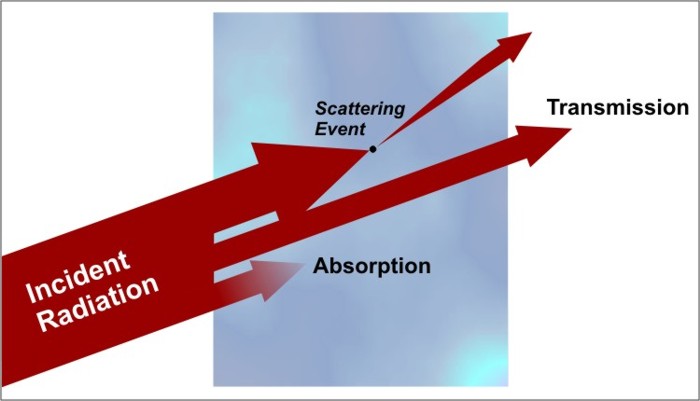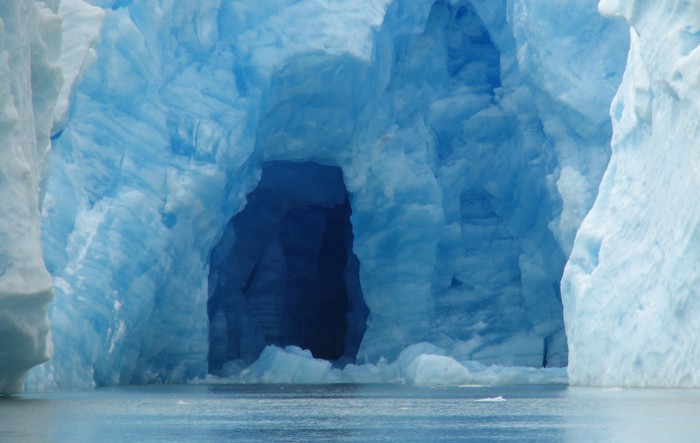 Prioritize...
Prioritize...
After completing this section you should be able to describe absorption, transmission, and scattering as it pertains to electromagnetic radiation passing through a medium. Read...
Read...
Unlike the traveler in Robert Frost's poem, The Road Not Taken, electromagnetic radiation doesn't have much of a choice whenever it encounters objects in its direct path. Indeed, the fate of electromagnetic radiation depends on wavelength and the physical composition of the atoms and molecules in the medium that it is passing through. It is impractical (and impossible) to sort through each atom and molecule in a given object in order to judge its potential effect on the incident radiation, so we will consider chunks of matter as whole objects in order to describe the net effect of radiation incident upon them.
When radiation first encounters some medium (whether it be a collection of gasses, a liquid, or a solid), only three things may occur to that radiation. The electromagnetic energy can either be absorbed by the medium, scattered by the medium, or it can pass through the medium unaffected (a process called transmission). In most cases, all three processes can and do occur to some degree. Examine the figure below showing the three processes that can effect radiation passing through a medium.

To begin our discussion, let's start with transmission (it's an easy one). Transmission is essentially the process by which radiation passes through an object unaffected. An example of a medium with a high transmission value is window glass. Light that passes through a thin sheet of glass does so basically undisturbed -- hence we can see objects clearly on the other side. We tend to call such objects "transparent", while mediums having low transmission values are called "opaque". I should also mention a few caveats about transmission. First, 100% transmission is rare, except within the vacuum of space. There is always likely to be some loss of energy via absorption and/or scattering as radiation moves through some medium. Second, the transmission properties of a medium are highly dependent on wavelength. For example, an object that is transparent in the visible wavelengths might be opaque in some infrared wavelengths.
Next, let's talk about absorption. Absorption is the extinguishing of a portion of the radiation beam. When an object absorbs electromagnetic radiation, that radiation is taken up by the matter (typically by the electrons of an atom). Absorption converts electromagnetic energy into other forms of energy, usually heat. Like transmission, the amount of energy that an object absorbs depends on the wavelength of the radiation and the physical make-up of the object. For example, freshly fallen snow absorbs little direct sunlight, but snow readily absorbs infrared radiation.
The atmosphere, like snow, is also a highly discriminating absorber, selecting only certain wavelengths of electromagnetic radiation to absorb. The plot of absorption spectra by various gasses indicates how efficiently certain gases and the atmosphere, taken as a whole, absorb various wavelengths of electromagnetic radiation. To interpret the graph, note the "0 to 1" scale on the left of the plot, indicating zero percent absorption and 100 percent absorption, respectively. At any specific wavelength, the upward reach of the color shading indicates the percentage of absorption by a particular gas (or the atmosphere, taken as a whole).
For example, focus your attention on the row for oxygen and ozone, labeled "O2 and O3". Note, to the left of this label, that nearly 100 percent of the radiation emitted at wavelengths ranging from 0.1 to about 0.3 microns is absorbed. Recall that these wavelengths correspond to potentially dangerous ultraviolet radiation emitted by the sun. Ozone, a gas composed of three oxygen atoms (O3), absorbs much of the incoming ultraviolet radiation. Most of this absorption takes place in the stratosphere, which is a layer that spans from 10 to 30 miles above the Earth's surface. Thank goodness! Otherwise, cases of skin cancer and other afflictions associated with overexposure to the sun, would likely be much more rampant in our society.
Finally, the third process that can occur when radiation passes through a medium is scattering. Scattering occurs when radiation interacts with matter in such a way that it changes its propagation direction. Check out this great example of scattering below. A laser produces a highly focused beam of light waves all traveling in the same direction. However, since you can see the beam, you know that some of the light is being scattered out of the beam towards the camera lens. This scattering is likely produced by small particles of dust in the air.

Scattering can occur in all directions, although some directions are preferred, depending on the size and composition of the particles involved in the scattering event. If the radiation encounters a scattering event and continues on in a forward direction, the event is called "forward-scattering". Likewise, objects can also back-scatter radiation, meaning that they redirect the radiation in all directions back toward the source. In this case, I will sometimes use the word reflection as a loose substitute for "back-scattering". I caution you that there's a big difference between our loose use of "reflection" and the classic, pure interpretation of "reflection". The latter imposes the restriction that the angle at which radiation strikes an object must equal the angle at which the radiation is redirected from the object (think about how a billiard ball bounces off a bumper on a pool table). In some rare cases, the scattered radiation may retain the exact same direction that it initially had before the scattering event. When this occurs, the scattered light is counted in the "transmission" category (because it seemingly emerged unchanged from the medium).
I should point out that scattering doesn't have to be a one-time event. Often, radiation will enter an object and encounter many (hundreds/thousands) of scattering events before emerging. This is what happens to make clouds appear white on top and darker on the bottom (cue the obligatory storm photo). It's also what makes snow, salt, sugar, and milk white. Furthermore, multiple scattering increases the time that the radiation resides in the medium (as it bounces around unable to escape). This longer residence time increases the chance that the radiation will also be absorbed by the medium. A great example is the blue hue that ice can take on. Water tends to absorb red light at a faster rate than blue light, and multiple scattering can really enhance the effect (see below)!

Now that we have covered electromagnetic radiation, the laws that it abides by, and how it travels through space, we need to shift gears and focus on something we ultimately want to measure via remote sensing -- clouds. The detection of clouds by satellites plays a crucial role in weather forecasting. In the next section, we will discuss the four different genres of clouds. By knowing the physical features of these clouds, you, as an apprentice forecaster, will be better prepared to identify specific types of clouds using satellite imagery. Read on.